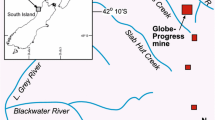Abstract:
Between 1948 and 1999, gold ore containing high concentrations of arsenopyrite was mined at the Giant Mine near Yellowknife, Canada. Processing resulted in 215,000 kg of gold and approximately 237,000 tonnes of highly soluble arsenic trioxide, a by-product of the roasting process. The arsenic dust was collected and placed underground in 15 shallow chambers and stopes (within 75m of the surface) with the understanding that the ground would revert to permafrost conditions once mining was completed. Subsequent studies have shown that the ground is unlikely to refreeze naturally; therefore, it has been proposed to actively freeze the arsenic trioxide storage areas to hydraulically isolate them from the post-closure ground water system. However, other arsenic sources (backfilled tailings, etc.) exist deeper in the mine (600 m total depth), so there is a concern that arsenic will leach into the minewater system and ultimately into the environment when the mine is allowed to flood. Therefore, the development and implementation of a remediation plan for the site requires a good understanding of the arsenic distribution and expected release to the mine water. To gain this understanding, a detailed program of surface and underground sampling was carried out to identify or “type” the inflow sources to the mine, and their interaction with arsenic sources both on the surface and within the mine workings. As of July 2005, the mine has been allowed to begin reflooding to reduce pumping costs and remove the need for servicing pumps at the bottom of the mine, thus allowing the main shaft to be taken out of service. Prior to starting reflooding, a multi-level monitoring system was installed in the main shaft and is currently being used to monitor reflooding levels and water chemistry. Samples can be collected from each mine level intersecting the shaft. The system will monitor reflooding rate and test how underground arsenic sources (backfilled tailings, etc.) are affecting water quality in the mine. This geochemical information will be used to assess long-term arsenic loading from sources outside the frozen zone and predict how long mine water treatment will be needed before natural ground water flow can be allowed.
Similar content being viewed by others
Author information
Authors and Affiliations
Corresponding author
Rights and permissions
About this article
Cite this article
Royle, M. Giant Mine: Identification of Inflow Water Types and Preliminary Geochemical Monitoring during Reflooding. Mine Water Environ 26, 102–109 (2007). https://doi.org/10.1007/s10230-007-0156-4
Received:
Accepted:
Issue Date:
DOI: https://doi.org/10.1007/s10230-007-0156-4




